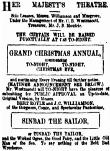Based on the popular pantomime story of Sinbad the Sialor, the narrative was played out in three acts, comprising the following scenes:
Act 1 Scene 1. Davey Jones' Locker. Cavern under the Sea;
Scene 2. Port of Balasora. A village Carnival. Hornpipe in Fetters. Sinbad's Departure;
Scene 3. Saloon of the Bobstay;
Scene 4. Wreck of the Vessel. Storm at Sea. Breakers Ahead. Neptune to the Rescue.
Act 2 Scene 1. The Royal Bath at Nowayer Patiklar. The Nautch Dance and the Ballet of the Harem;
Scene 2. The Mountain Pass. Topical duets;
Scene 3. The Diamond Valley. Ballet of thr Night Elves and the Grand Amazonian March. Starting Trap Scenes. Flight of the Fairy Rock and Escape of Sinbad.
Act 3 Scene 1. The King's Palace. Grand Variety and Specialty Scene;
Scene 2. The Palace Gardens. Recovery of the Koh-i-Noor;
Transformation Scene
Harlequinade
The production's music elements included the following songs and dances: 'Didn't I Run, Run, Run' (sung by Will Crackles), 'Rosie O'Grady' (Ada Baker), 'Il Bacio' and 'Canary Polka' (Frank Lawton), 'Darling Mabel' (Eva Clements), 'We'll Just Have Another and Then' (Crackles and Stanfield), 'Mary Used to Go to Sunday School' (Stella Esdaile), 'Remedies' (Stanfield), 'Love's Duet' (Phillips and Esdaile), and the 'Magnificent Trio Dance' (performed by Misses E. and A. Hooper and Frank Lawton).
 3524851084075357200.jpg
3524851084075357200.jpg
 Sinbad the Sailor, Or, Tinbad the Tailor, and the Wicked Ogres, the Good Fairy, and the Little Old Man of the Sea (To Say Nothing of the Bold, Bad Wreckeroo)
single work
pantomime
fantasy
-
Three acts.
Sinbad the Sailor, Or, Tinbad the Tailor, and the Wicked Ogres, the Good Fairy, and the Little Old Man of the Sea (To Say Nothing of the Bold, Bad Wreckeroo)
single work
pantomime
fantasy
-
Three acts.

